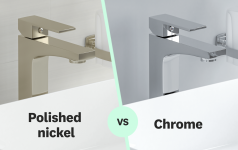I come from the metal working industry and I am very familiar with plating.
Early chrome plating was “triple chrome plated”. That meant the first coat was a “flash” of copper, which acted as a primer and assured good adhesion.
The second coat was a thick layer of the very soft nickel plating. Nickel buffs up really well and is the “polished” part of the polished chrome.
And finally a very thin layer of chrome which is a very hard finish and resists scratching well.
Modern chemistry for chrome plating baths has pretty much eliminated the flash of copper as being unnecessary.
Modern nickel plating is “self leveling” and generally does not require any post plating polishing.
Nickel has a very slightly yellow appearance and chrome has a slightly blue appearance. Those casts of colors are not usually noticeable unless a piece of chrome is placed next to a nickel plated part.
Bathroom faucets are typically made from zinc die casting, though some high end pieces may be made from solid brass.
The die casting is placed in a vibratory trough with media and water and the media polishes the casting to the smooth finish. The self leveling nickel is then applied and then the chrome.
So, it would seem that the nickel parts have one less process than the chrome parts, and yet the polished nickel faucets seem to be in the $250.00 to $500.00 range, and the chrome faucets are in the $90.00 to $175.00 range.
Note: There is now available a “plateable grade” of ABS plastics. Which means that the plastic can conduct electricity, a requirement of plating. The plastic parts come out of the mold with a perfect surface finish so no polishing is required.
Chrome plating is done on “racks” which generally means that the parts to be plated have to be placed on the rack by a human and removed from the rack when it has gone through the plating process. So each piece has a labor cost for racking plus the plating cost.
Plastic molded parts can be made on a “tree” with several components attached to one tree. These can be racked as one piece, even though several are getting plated at a time.
So cheap faucets are often made from this ABS. I am not very familiar with the process, but I think the chrome goes directly on the parts with no nickel and no copper.
(Sorry for the long dissertation.)
But my point is that it seems that nickel parts would cost less than chrome by a small margin (there is one less step). But, in fact the nickel parts cost more by a multiple of the cheaper chrome parts.
I don’t understand that.

